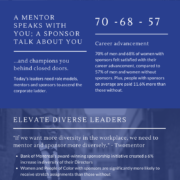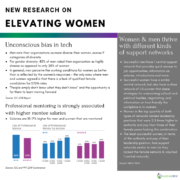Why in 2020 We Must Have Corporate Mentoring Program Goals
/in Business Case for Mentoring, Development, Employee Retention, Inclusive Mentoring, Uncategorized/by Julie KantorWhy Corporate Mentoring is the Key to Success!
/1 Comment/in Business Case for Mentoring, Employee Retention, Inclusive Mentoring, Mentoring, Millennials/by Julie KantorWant an 88% Boost in Productivity? Say YES to Mentoring Your Managers
/in Business Case for Mentoring, Mentor Training, Uncategorized/by Julie KantorMars & Venus? Big New Studies on Women in Tech from IDC and Northwestern
/in Business Case for Mentoring, Inclusive Mentoring, Mentor Training, Mentoring/by Julie KantorHigh Turnover Costs Way More Than You Think
/in Business Case for Mentoring, Employee Retention, Mentoring/by Julie KantorWritten with A. Crosser
I remember almost leaving my company in 2006. I was lying in bed, dejected and upset. My corporate mentor called me and talked me off the ledge. He told me I was highly valued at a time I was feeling undervalued. Over the course of our deep conversation, I realized that I had likely misinterpreted a situation and I needed to get out of bed, stand back up and not be corporate roadkill…
It’s well-known that employee turnover rates come as a high cost to companies, however very few discuss the true extended costs and the multiple ways that it impacts the business. It’s important that successful business not only find the best employees, but keep them engaged as well. In one of my most recent articles, we discussed losing a Millennial employee can costs the company $15,000 to $25,000, but it’s actually a lot more when you weigh in a few additional variables.
First, let’s take a look at the hard costs of high turnover. What is a company going to spend in order to compensate for low retention rates? According to a study by the Society for Human Resource Management, employers will need to spend the equivalent of six to nine months of an employee’s salary in order to find and train their replacement. Doing the math, that means that for an employee salaried at $60,000 will cost the company anywhere from $30,000 to $45,000 to hire and train a replacement. Other research show that the average costs could be even higher. In a study conducted by the Center for America Progress, the cost of losing an employee can cost anywhere from 16% of their salary for hourly, unsalaried employees, to 213% of the salary for a highly trained position! So if a high trained executive is making $120,000 a year, the true loss could be up to $255,600 to the company!
Perhaps getting rid of Thursday Happy Hour, flex-time, or reducing paid maternity leave was not such a good idea after all.
The question then becomes, why does losing an employee cost so much, and in what other ways do high turnover rates impact a company? From there we look to what can be done to keep strong employees engaged and happy at the company. Not just surviving but thriving at work.
- The Cost of Training and On-Boarding
Training an employee is not free, and is often relatively expensive. Training seminars and classes can cost a business thousands of dollars, and they can also result in the understaffing of other departments, as training sessions will often need to be led and monitored by other employees of the company. This can result in lowered productivity, and as Zane Benefits, points out the overworking of other employees making up for those who need to conduct training.
- Interview Expenses
Conducting interviews is a long and tedious process. Many expensive mistakes can be made here in picking the wrong candidate. In order to lower turnover rates, it’s important for businesses to ensure that they are hiring the best candidates for the job, individuals who will be more likely to stay and grow with the company for an extended period. The interview process can include travel expenses if candidates from out-of-town are being considered, which add up quickly. Outside of monetary expenses, the interview process takes immense amounts of time, with company leaders needing to take hours out of their day to conduct the meetings. Much like training, time spent on interviews costs the business by way of lost productivity.
- Advertising Costs
Posting ads promoting the vacant positon can cost a company a significant amount of money, with most job boards charging a hefty fee to employers looking to advertise. These costs add up over time, meaning that the company could be looking at serious expenses to advertise new positions. Hiring a good external recruiter is a great way to decrease time on task, but the recruiter will often charge 25-33% of one year salary for senior positions.
- Lowered Engagement
I can’t tell you how many calls I receive from people distraught when they see good people and friends leaving their companies. High turnover rates will most definitely be noticed by staff who remain employed by a business, and this can often result in lost engagement on part of these employees. They will often feel that the ship is taking too much water if too many people leave, overworked, and thus less satisfied and less motivated at work.
- Productivity of New Hires
When a company is faced with the need to hire new employees, they also face a severe decrease in productivity. As discussed before, remaining employees may lose focus due to high turnover, however the productivity of the new hires is also an issue. According to business expert Josh Bersin, of Bersin by Deloitte, a new employee can take up to two full years to reach the same level of productivity as an existing staff member. Lately, I have been thinking of the workplace like a blended family. Having new stepbrothers and sisters, uncles and cousins come into the ‘work’ family can be a lot of fun, but also can be riddled with new and unexpected challenges, turf wars, feelings of displacement and hurt feelings if not integrated and on-boarded right.
- Impact on Morale & The Gossip Machine
When other employees leave, the remaining staff will wonder why and the gossip machine commences. If an employee leaves for a higher salary, other employees may interview for other higher-paying positions elsewhere. According to Forbes, employees expecting a raise can expect to see an average of 3 percent, however being recruited for or finding a new position often results in a 10-20 percent raise, meaning that the company has to further compensate for lost staff members. Additionally, if employees left unhappily based on workplace culture issues, they will often communicate with their friends sharing a brighter life/ opportunities available on the other side. I don’t want to diminish in any way the psychological impact that an employee goes through in transition regardless of who’s decision it was to part ways. Transitions are tough but sometimes employees know they can’t get to second base with their foot still on first/
- Less Effective Service
When hiring for a customer service position specifically, new hires generally do not know the answers to typical questions they will face on the job. For example, if a company needs to hire several new employees to fill IT Help Desk positions, they will take longer to resolve common issues, and it could potentially result in the loss of customers, should they be unhappy with the changes.
So what is a company to do? After all transitions are a given in any company.
Perhaps we can learn something from youth in the New York City schools.
Professor Jonah Rockoff researcher out of Columbia University illustrates that mentoring not only reduces employee turnover, but also improves the skills of new employees, increasing the amount of productivity that you will see in the newly on-boarded staff members. After studying the habits of students in New York City schools and how they perform with and without mentors, Rockoff found that students who received mentoring had the best performances out of all of the students observed, and that they had a lesser chance of dropping out than students who were not mentored. These observations can be applied to business as well, with the concepts of mentoring remaining the same. Rockoff states that when an employee receives specialized attention and training from a mentor, they will perform better on the job, and will be much more likely to stay in the workplace. These concepts have been proven in corporate giants like Google, who have one of the lowest employee turnover rates in the world, and also implement one of the most effective mentoring programs.
There are many costs associated with high turnover, but there are a multitude of ways to reduce it. Mentoring is one of the most effective, cost efficient ways of increasing employee tenure benefitting the mentor, the mentee and driving significant retention.
So when my mentor called me that day from his business trip in Hong Kong, we had a deep and honest discussion. I deleted the resignation letter I had been drafting, dusted myself off, worked through the issue and continued loving my two decade career for many more years.
Julie Kantor is Founder & CEO of Twomentor, LLC a management consulting firm focused on building mentoring cultures and retaining a diverse STEM workforce.
Have You Tried Flash (Speed) Mentoring Yet?
/in Business Case for Mentoring, Employee Retention, Mentoring, Millennials/by Julie KantorWhen I started Twomentor a year and several months ago, my intention was (and is) to go in and help companies build mentoring cultures for so many reasons. I had already spoken with 500- 600 companies and institutions that were struggling with hiring and retaining diverse talent, especially in the Science, Tech, Engineering and Math (STEM) arena. Not one company would disagree that culture and employee engagement needed focus + leaders understood that the economics of loss are troubling, especially when you factor in that it can cost @ one year salary to replace an executive, over 200% for a key Sales executive, and that Millennials — well, 21% left their jobs last year costing companies billions.
Did you know- Over 75% of Millennials view being mentored as crucial to their professional success? Did you know most women leave their jobs because they do not have a Sponsor (advocate, inner champion).
So I landed at a Leadership Conference in Chennai, India last February at an NGO Leadership Conference through the Center for Social Leadership & Sevalaya, and decided to take concepts such as reverse mentoring, peer mentoring, diverse mentoring, and integrate them into what has now become The Twomentor – Mentor Road Trip™ Experience. I didn’t realize at the time, how powerful this would be for participants and the places it would take me personally as a new CEO.
So what does it look like? Well, let’s hit the gas…
Mile Seven: So you are driving in your car with your awesome new mentor. (or mentee)… clear blue skies ahead… Starbucks double espresso warms your hand (or perhaps you prefer Dunkin Donuts). You have an updated Spotify playlist for background music, a GPS and a full tank of gas. Then … Uh-ho! Flat tire.
Twomentor: “Flat tires happen in our professional lives. Sometimes, it is our batteries that need to be recharged. I now want you to share a professional challenge big or small that you are having right now with your mentor. Take 10 minutes on this leg of our journey together…”
At Leadership Greater Washington, at the World Bank Group, at Women in Technology and a huge packed ballroom in Vegas for InfoComm International and Watermark Executive Women’s Conference in San Jose, we have run these customized experiences. The proverbial conference spotlight moves from the stage to shine a light within the audience. We transform and we become each other’s mentors, consultants, we light up realizing others in this multi-cultural, multi-generational environment have insights, perspective and solutions. No longer are we passively staring at the stage, we are now engaged, playing our part and creating meaningful interactions. We find commonalities and wish we could continue the conversation for another 30 minutes… but… the bell rings… we now need to switch partners.
Mile Eleven: “For this next segment, friends we want you to find someone in the room that DOES NOT remind you of yourself. Does not look like you (diverse mentoring). Please share with your mentee what drives your passion to do the work you do in tech, engineering, sales… each day.” Let’s Go.
They are listening to each other, heads nodding up and down, understanding, animated. Amazing that no one really knew each other twelve minutes ago. At the Gannett Building in McClean, VA I walk around observing over 60 women through Women of Technology and Women of AT&T going the extra mile for each other. Sparkling, smiling, intent at our post-dinner evening session. I see mentors wear the hat for the first time in years of the mentee. Asking for help from others. So many women I met shared after these sessions that they are always helping and mentoring others, but they were burning out because they were no longer asking others for help… It was a revelation. Senior male and female leaders always want to discuss Sponsorship offline.
“As an over 40 career professional, I was mentored by a Millennial in Twomentor’s workshop. While it was great to learn about my mentor’s passion and hear her advice, what was even more important than the learning was the feeling we experienced. This pairing put me in a position of vulnerability and my mentor in a place of courage. And coming away from this, I realized these emotional states were exactly what each of us needed to grow who we are as career professionals. I needed a beginner’s mind, and she needed a stronger voice. Brilliant!”- Sarita Vasa, Participant
“Shake your partners hand, thank them for the great mentoring and we are ready for the next leg of the journey. Mile Seventeen: We live in a Global economy where new skills are required… Lifelong learning is required. Please share a technology… “
Attendees moved on and then moved on again to Mile 84. The business cards were exchanged, the new connections made, dozens of follow-up coffee dates planned and then we pulled into our rest stop to refuel and say our goodbyes for now… continuing our learning for the day.
Reflecting in the rear-view mirror, Flash mentoring is an effective jump-start to the culture of mentoring at organizations. It does not replace a strong, metrics-based high performing mentoring initiative, it simply revs the engine and can ignite the value-proposition + clarity for groups to get started. A lot of companies are trying a low-touch solution for a high-touch problem. Well, that’s where we come in. Flash mentoring is dynamic, it’s inclusive, and it’s fun whether 40 people are in the room or 1400.
—-
Julie Kantor is the Founder & CEO of Twomentor LLC and passionate about elevating women in STEM and driving mentoring cultures. You can reach her directly at info@twomentor.com Learn about Twomentor including webinars, peer to peer world cafe learning and much more.
NEW DATA: Your Corporate Mentoring Program Will Need More Attention
/in Business Case for Mentoring, Mentoring/by Julie KantorCo-written with Kate Ward, Head of Partnerships InHerSight
Mentorship programs get a lot of buzz as the key to improving gender equality in the workplace. As more and more companies look for ways to increase representation of women at senior levels, mentorship or sponsorship is often cited as a key to helping women reach that next rung on the corporate ladder. And many powerful women, such as Sheryl Sandberg, have cited the importance of mentors to their personal career success.
With approximately 75% of Fortune 500 companies offering formal mentoring programs and 25% of U.S medium and large companies offering programs, corporate America has embraced the idea, but are these programs achieving their potential?
Are people being thrown together without a lot of thought to what the experience should be?
Are companies understanding the true business case for mentoring and what it means to all parties?
Do we recognize the act of mentoring, and the people who mentor as the ones who help drive engagement and retention at our companies?
Are mentors and mentees being trained?
We spent some quality time with the dynamic team at workplace review site, InHerSight. They have collected employer ratings from tens of thousands of women. One of the 14 metrics they get feedback on is women’s satisfaction with her company’s “mentorship and sponsorship programs”. We have written a lot about sponsorship in earlier posts. Turns out, at least among women, corporate mentorship programs could really use some work and investment.
A recent review of their data found that “mentorship and sponsorship programs” is the lowest rated metric of all 14 that they capture with an overall score of 2.2 out of 5 stars.
InHerSight’s research also found that a company’s mentorship program is highly correlated with women’s overall satisfaction and happiness at a company, which means if your female employees are unhappy with your mentorship program, they are more likely to be unsatisfied at work.
And here’s where the data was most interesting, a deeper dive showed that women’s satisfaction with their company’s mentorship program is a stronger predictor of overall satisfaction at a company the later women are in their careers.
Our assessment, women as they grow in their careers truly want to see others self-actualize. They also want to build stronger sponsoring relationships to feel validated, supported and championed in their careers.
Julie Kantor is the CEO of Twomentor, LLC a management consulting firm that is passionate about building mentoring cultures to drive retention.
Don’t Have Time to Mentor? You Might Want to Rethink That
/in Business Case for Mentoring, Development, Employee Retention, Mentoring/by Julie Kantor“I have talked more people off a ledge from leaving our company,” said Cheryl* CEO to her leadership team. I watched her in awe. She is a true leader who gets the power of people, the power of a pay-it-forward culture. After all, she was part of a strong chain of leaders who championed her and she respectfully claims that honor and wants to see the legacy continue. With the cost of losing an employee is 100–300% salary (SHRM), I cannot help but start putting dollars on a virtual excel spreadsheet for all the casualties that did not happen as a result of her interventions. The value of those authentic talks. The value of taking the time to see the people who work with you, for you, your peeps, your companies future.
Cheryl put a much stronger stake in the ground when she announced that she was connecting bonuses to “how we invest in our people,” with mentoring being one key strategy. She understands that an investment in people = a stronger workplace culture = retention = engagement + productivity = =revenue and ROI= more smiles.
As I took the stage at Cheryl’s conference, Bob’s conference, Darren’s corporate conference and dozens more through my work @Twomentor I always ask the question “How many of you have a mentor and/or someone you go to for professional advice?” The answer, please take this in, is under 40% even in the highest levels of our rockstar companies. I ask what the impact has been of having a mentor (or sponsor)? I “wouldn’t be where I am today”, “my mentor challenged me,” “he believed in me, changed my life” “kicked my a — and showed me where I needed to grow,” and so much more).
My next question is “How many of you currently mentor other people?” Always under 20% stand up. WHAT@!#! Most companies err in believing mentoring should just happen holistically. I believe more and more we need to engineer it in a dynamic fun way with creative flexibility. I believe people are afraid to look weak in asking for help or intrusive in offering help. But the help of each other is the bridge where magic occurs.
We also are confronting a loneliness epidemic in our country and it’s hitting our youngest the hardest. It’s not just “lonely at the top” anymore. In fact, recent overall studies that show that 54% of American’s feeling lonely and isolated.
Darren stood up at the conference after a flash mentoring session. He had a management problem that was nagging him for weeks related to his new promotion. “I was concerned about it every waking moment,” he shared. He found his answer and began action planning following a speed mentoring conversation with a seasoned leader. “When he was talking, chills just went over my body,” said Darren at the conference. “I knew he was right and I had gone to my manager and others, but he was the one who made me see a solution I hadn’t seen.”
Nice to have or have to have? I have the time or I don’t have time is the question you will have to answer for yourself and your company. … and having a leader like Cheryl at the top quadruples the chance of systemic success.
For your own time, if you go with “Yes” I will carve out 10–20 hours a year to mentor others or ask for help, get started. Schedule that walk and talk or that drive to Peet’s Coffee.
“Mentoring is a muscle you flex, it grows stronger the more you use it,” says Cheryl.
—
Julie Kantor and her team at Twomentor are here to help you build or boost a sustainable mentoring initiative to retain your best talent. She can be reached at julie@twomentor.com
Four Key Benefits of Workplace Mentoring Initiatives
/in Business Case for Mentoring, Development, Employee Retention, Mentoring/by Julie KantorCo-written with A. Crosser
Q: What increases employees’ education and learning; saves company high turnover costs; develops leadership and management skills; and saves people time and money to focus on the big priorities?
A: Workplace Mentoring
When examining companies and how they became remarkably successful, one trait which stands above many others: successful companies have excellent leaders, and with excellent leaders come excellent employees. Leadership and guidance is very important to success in nearly every field, and workplace mentoring is one way to provide personalized leadership for both new and tenured employees. Skills-based Mentoring is part of on boarding to teach new executives the company ropes and to help them excel and grow as they continue their position.
Mentoring programs are becoming increasingly popular in workplaces, as they help in reducing turnover, promoting growth, and overall help employees adjust to new positions as well as become prepared to move up in the company. We shared earlier that over 79% of Millennials see mentoring as crucial to their career success. According to Chronus Corporation, over 71 percent of Fortune 500 companies offer mentoring programs, showing that mentoring programs are becoming a standard in many workplaces. This begs the question, why are so many successful businesses incorporating mentoring programs, and what benefits do mentoring programs offer?
- Education and Learning
There is no debate that educated, well-trained employees produce better results in the workplace than employees who lack knowledge and training. Nearly 80 percent of all learning is considered to be informal, meaning that it is not done by reading or taking classes, but rather by learning on the job and from others. By introducing mentoring programs, businesses can ensure that their employees are able to complete their work with knowledge of the field and their position. Mentors will elevate and escalate “knowledge transfer,” which is useful in shortening a learning curve in the workplace, meaning that companies can have highly-productive employees in a much shorter period of time then they would have had mentors not been implemented.
- Reducing Turnover Rates
One of the main benefits of mentoring programs is that mentors can play a major role in reducing the turnover of employees, meaning that the company will not have to invest in training new employees as often as they would with a higher turnover. Diversity & Inclusion leader Dresdene Flynn-White shared with us that the loss of one good employee costs on average a years salary. By providing personalized advice to a mentee, a mentor can help to ensure that employees will work through any frustrations or concerns they may have, help them build the skills they need for success, encouraging them to stay with the company and grow there for a longer period of time. By keeping employee turnover rates low, companies will continually have experienced personnel, rather than the burden of constantly training new employees to replace those who left.
- Development of Leadership and Management Skills
Having employees who are ready to step into management positions in the business with minimal training is highly valuable, as it reduces the need for external hiring, ultimately saving the company time and money. By implementing a mentoring initiative, mentors can assist in teaching leadership skills to employees showing potential for future leadership positions. In addition, mentors reduce turnover rates, meaning that providing mentors for high potential employees will improve the chances of them staying with the company long enough to progress into a leadership position, reducing the need for outside hires.
- Time Savings and Focus
Implementing mentorship strategies is an excellent way to save time in the workplace. By implementing mentors, employees with questions or concerns can often work with the mentor on a resolution or answer, reducing the time needed to get tasks finished, which overall improves productivity. Mentors also reduce the formal training necessary for new employees; by providing new employees with a ‘project-based’ mentor, they can learn on the job, rather than in a training room. Managers and bosses will can therefore spend more time working on tasks more imperative to the success of the company, making mentoring a win-win for the employees and the company leaders alike.
So bottom line, mentoring can be a WIN/WIN/WIN (for the company, the mentor, and the mentee) but it has to be imbedded formally into the culture of the company. A need to have, not a nice to have. Additionally, recognizing & valuing employees who take time to mentor and those who lead the initiatives needs to be on every HR and team leader’s priority list.
References:
http://chronus.com/resources/daimler-trucks-reinvents-corporate-mentoring-program
http://management.fortune.cnn.com/2012/04/19/peer-mentoring
http://knowledge.wharton.upenn.edu/article.cfm?articleid=1736
http://smallbusiness.chron.com/benefit-company-gain-mentoring-programs-20665.html#
https://www.virgin.com/richard-branson/the-importance-of-having-a-mentor-in-business
Julie Kantor is the CEO of Twomentor, LLC a management consulting firm that provides mentor training, strategy and global speaking to elevate women and millennials in STEM.









